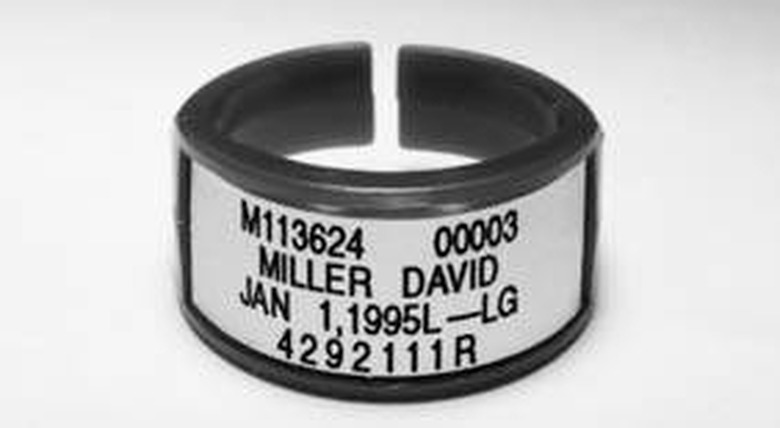How Do Dosimeters Work?
Though we are exposed to radiation constantly – in the form of sunlight – and all wavelengths of light can be considered radiation, some forms of radiation are more harmful to humans than others. In the same way that too much sunlight can cause a sunburn or skin cancer, overexposure to X-rays, gamma rays and certain radioactive particles can cause anything from blindness to serious cell damage to death. To prevent this, every person working with, in or around radioactive substances or environments wears a dosimeter – sometimes referred to as a radiation badge, radiation band or TLD detector. These simple devices allow wearers to keep track of the radiation they're absorbing, to prevent them from falling ill and to determine how hazardous a radioactive environment may be.
TL;DR (Too Long; Didn't Read)
A radiation dosimeter is a scientific instrument used to measure exposure to ionizing radiation. Commonly worn in the form of a badge or bracelet, these meters contain phosphor crystals capable of trapping electrons freed by harmful ionizing radiation. When heated, the crystals release trapped electrons in the form of light – which can be measured to determine how much radiation the meter and its wearer have been exposed to. Dosimeters are used by researchers, maintenance staff and anyone else working in a potentially radioactive environment.
What Is a Dosimeter?
What Is a Dosimeter?
A dosimeter is a type of scientific instrument, used to measure exposure. While certain types of dosimeters can be used to track exposure to loud noise, the most common type of dosimeter used is the radiation or thermoluminescent (TLD) dosimeter: These dosimeters, taking the form of small badges or wrist bands worn on the body, are used to measure the dosage of harmful radiation that their wearers have been exposed to over a given period of time. Dosimeters contain phosphor crystals that trap electrons freed by various forms of harmful radiation; worn over the course of one to three months, these crystals can then be used to determine radiation exposure through a process known as dosimetry.
How Radiation Dosimetry Works
How Radiation
Dosimetry Works
Ionizing radiation, caused by exposure to X-rays, gamma rays and certain radioactive particles, is a type of radiation that carries enough energy to knock electrons off of normally stable molecules. When this occurs in living tissue, the loss of electrons can cause cell damage – but those same freed electrons can be captured and measured under the right conditions. Radiation dosimetry works by taking advantage of this: When electrons are freed by ionizing radiation, they can be captured within phosphor crystals, like those that compose dosimeters. When phosphor crystals that have captured electrons are heated up, the crystals release these trapped electrons in the form of light, which can be measured to accurately determine the amount of radiation the dosimeter was exposed to.
Common Dosimeter Uses
Common Dosimeter
Uses
In contrast to the more familiar Geiger counter, a scientific instrument that measures the amount of radiation present in a given area from moment to moment, the various types of radiation dosimeters are used to track radiation exposure in an area or in a person over a prolonged period of time. Dosimeters can be placed on their own in radioactive environments to track the average amount of radiation given off, but most often they are worn by researchers, maintenance staff and other officials working with or around radiation. The staff of many university departments wear dosimeters, as do staff at nuclear power plants and some hospitals. Chemotherapy patients will often wear dosimeters as well during treatment, to ensure that the amount of radiation they're exposed to stays in the helpful range, rather than entering a potentially deadly one.
References
- Oak Ridge Associated Universities: Pocket Chambers and Pocket Dosimeters
- University of Maryland: Dosimetry Information
- University of Iowa: Dosimeter Guidelines – Diagnostic Radiography & Fluoroscopy
- NDT Resource Center: Thermoluminescent Dosimeter
- Duke University: Your Radiation Dosimeter: A Tutorial
- University of Texas Health Science Center at Houston: Personal Radiation Dosimeter
Cite This Article
MLA
Flournoy, Blake. "How Do Dosimeters Work?" sciencing.com, https://www.sciencing.com/do-dosimeters-work-5167635/. 30 November 2018.
APA
Flournoy, Blake. (2018, November 30). How Do Dosimeters Work?. sciencing.com. Retrieved from https://www.sciencing.com/do-dosimeters-work-5167635/
Chicago
Flournoy, Blake. How Do Dosimeters Work? last modified March 24, 2022. https://www.sciencing.com/do-dosimeters-work-5167635/
